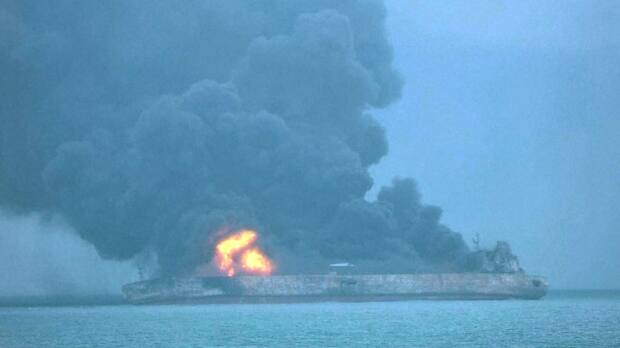Articles Menu

It's an oil spill the size of Paris. But only now is the world's attention catching up with the vast scale of the disaster in the East China Sea — the largest tanker spill in decades.
The crash itself happened weeks ago when an Iranian tanker called the Sanchi collided with a Chinese freighter on January 6 and burst into flames, later sinking. Thirty-two crew members are presumed dead.
It's a different kind of oil spill, though, and that's what's causing concern. Almost one million barrels of condensate were on board, an especially flammable type of light oil.

The spill took place in the East China Sea, an important fishery area for China, Japan and South Korea. (Google Maps)
"There's a lot we don't know about a major condensate spill because we've never seen one. This is the first," says Richard Steiner, an Alaska-based marine scientist and an oil spill consultant.
"This is a very big deal."
Light oil is hard to see, making it difficult to know where it is or where it has travelled.
"I'm sure the toxic plume that dissolved in the water column has already spread over hundreds of square miles of the East China Sea," Steiner says.
"There has been serious ecological injury."
Tanker and freighter collide off China1:35 [see video with original]

The East China Sea is an important fisheries area for China, Japan and South Korea, home to whales, seabirds and hundreds of species of commercially harvested fish.
Jonathan Watts, The Guardian's global environmental editor, figures that potentially "millions of fish were affected" by the spill.

A rescue ship works to extinguish the fire on the Sanchi. 32 crew members from the tanker are presumed dead. (China Daily via Reuters)
"It's quite possible a lot of them will end up in the supermarket shelves, particularly in those three countries," he says. "There's a big mystery, a big fear, about exactly where all this this huge amount of toxic oil has gone."
Steiner has recommended that nearby fisheries shut down their operations until they can prove that the fish are safe and aren't contaminated.
It's been difficult getting that word across, though. Miguel Quintana, a freelance journalist based in Tokyo, has been following the spill there and tells The Current he has seen little to no coverage in the local news.

The blazing vessel, which had been carrying 136,000 tonnes — almost one million barrels — of condensate, an ultra-light, highly flammable crude oil, sank after several explosions weakened the hull. (10th Regional Coast Guard Headquarters/Reuters)
"That to me is shocking and raises very important questions about not just the role of the media but how they function," he says.
"I'm not trying to point fingers here but what I'd like to do ideally is get people in this country to think about it and what it means for them, for their democracy and for whatever else coming down the road."
Steiner is frustrated and disappointed there hasn't been more coverage and pins part of the blame on the Chinese and Japanese governments for not being forthcoming.
"It's a lot easier to be open and honest about these things than to attempt to cover them up and conceal the truth," he says. "That's what they need to start doing immediately."
He also says the spill should be a "wake-up call" for Canadians, calling it a "real and growing risk" here. Condensate is coming into Canada by pipeline and tanker, particularly in B.C. and Alberta.

The collision marks the biggest tanker spill since 1991, when 260,000 tonnes of oil leaked off the Angolan coast. (CCTV via AP Video)
"When you see images of the Sanchi exploded and on fire and sinking and dead crew and the pollution of that, just imagine Kitimat and Douglas Channel and Haida Gwaii and Prince Rupert and Hartley Bay and you get the picture pretty quickly, the risk we're taking."
This segment was produced by The Current's Idella Sturino, Kori Sidaway,and Exan Auyoung.
[Listen to the full audio from the original]
[Top photo: The Iranian oil tanker Sanchi is engulfed in fire in the East China Sea, on Jan. 13, 2018. (China Daily via Reuters)]